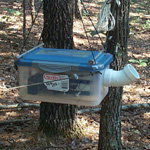Fragmented Forests Could Lead to Habitat Disaster
Media Contact:
Jennifer Martin, CSREES Staff
(202) 720-8188
By Stacy Kish, CSREES Staff
April 1, 2008

Anabat device for recording bat calls in protective container in forested setting.
Credit: Mark Yates
As city dwellers seek a different way of life, the exodus from the urban environment to rural settings is increasing fragmentation of central hardwood forests. With funding from USDA's Cooperative State Research, Education and Extension Service (CSREES), researchers in Missouri, Indiana and Tennessee are using Geographic Information System-based landscape simulation models to aid landowners when making use and management decisions. The models will also help predict forest reaction to harvest events in order to gain valuable insight for wildlife and habitat conservation.
Nearly half of all forested land in the United States is privately owned; however, the average acreage of ownership has decreased significantly in recent years. With more individuals owning smaller tracts of forested land, the resulting landscapes are being fragmented. The small segments of forested land render forestlands, as well as other wild-lands, increasingly vulnerable to urban development. The fragmentation results in a lack of similar habitat, which degrades environmental conditions for wildlife.
Bill Kurtz and colleagues at the University of Missouri, Purdue University and the University of Tennessee-Knoxville examined landscape fragmentation at three watersheds in Missouri, Indiana and Tennessee. The scientists found that the presence or absence of habitat main lands and riparian corridors significantly affected wildlife's ability to survive in the highly fragmented areas.
The scientists applied two decision tools in this study. They used a PC-based tool in Missouri and a Web-based tool in Indiana to aid private landowners when making management decisions regarding private land holdings. These tools provide private land owners a clear understanding of the consequences of their management actions to the environment, ecosystems, and wildlife and foliage health.
In Missouri, three management options were proposed: no treatment, thinning from below and diameter limit cut. The parameters for each option were entered into the database. In addition, photographs were entered into the database for the majority of forest characteristics, including forest type, forest size and forest density.
For Purdue, a Web-based tool was established to estimate forest dynamics and wildlife habitat availability over the past 40 years. The input for the database includes the forest type, forest size and forest density for separate forest stands. The Web-generated output includes temporal changes in commercial timber in relation to changes in the diversity of plants, including berries, ferns, herbs, and flowers, as well as animals, including birds and mammals.
Both tools provide representation of the results from application of management alternatives in tables and pictures, enabling landowners to see, in a virtual sense, the impact of their management decisions.
Forests provide products, aesthetic and recreational services, intrinsic satisfaction, monetary gain from conserving this natural resource and a part of a community's heritage.
CSREES funded this research project through the Initiative for Future Agricultural and Food Systems (IFAFS) program. Through federal funding and leadership for research, education and extension programs, CSREES focuses on investing in science and solving critical issues impacting people's daily lives and the nation's future. For more information, visit www.csrees.usda.gov.
#
Last Updated: 04/01/2008





